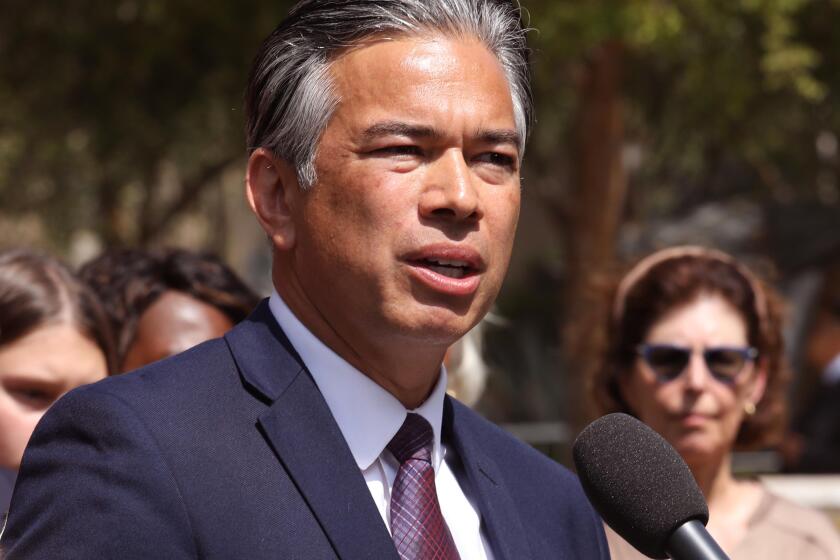Senator Wants Tougher Action in S&L; Cases : Thrifts: The head of the Senate Banking Committee says the Administration hasn’t asked for enough funds to pursue the perpetrators.
- Share via
WASHINGTON — Joining a rising chorus of political anger over savings and loan fraud, Senate Banking Committee Chairman Donald W. Riegle Jr. (D-Mich.) on Monday called for “a more aggressive crackdown” on the white-collar criminals who helped cripple the thrift industry.
“The need for additional investigative and prosecutorial resources is unlimited,” Riegle said in a major Senate speech. He accused the Bush Administration of failing to ask for enough funds to pursue the perpetrators of financial fraud.
A Justice Department spokesman fired back at Riegle, saying “it’s too simplistic to suggest more money means more cases investigated and prosecuted.”
S&L; fraud cases “are hard cases to make,” said Douglas Tillett, the Justice Department spokesman. “We have to bring evidence and prove guilt--members of Congress can hold a press conference and not be accountable for their grand ideas.”
Riegle, a key author of the 1989 S&L; rescue bill that provided funding for the sale or shutdown of hundreds of insolvent thrifts, added his influential voice to a new wave of criticism sweeping through Congress. Lawmakers are among those having to cope with the political fallout from the biggest financial scandal in American history.
Because savings deposits are insured up to $100,000, taxpayers will bear the massive financial burden for cleaning up the defunct S&Ls; and disposing of their assets. The Bush Administration said last month that the cleanup cost had been badly underestimated. It said it would need as much as $60 billion more for the job.
Although the complexities of the scandal have been slow to penetrate the public consciousness, politicians draw big applause when they call for retribution against those who helped loot S&Ls.;
Congress authorized $75 million for prosecuting thrift fraud, but the Administration limited its request to $49 million, Riegle said.
“The Administration opposition to additional funds for savings and loan fraud prosecutions is difficult to reconcile with available evidence on the magnitude of the problems and the Justice Department’s current resources,” Riegle said.
The Justice Department spokesman said his agency is spending the fraud-prosecution money effectively and doesn’t need more. “To appropriate money in December, 1989, and expect to put people in jail in June, 1990, is a little unrealistic,” Tillett said. The Justice Department has created 155 new slots for FBI agents and 118 for assistant U.S. attorneys, but needs hundreds more, Riegle said.
His willingness to write a virtual blank check to pay for S&L; fraud prosecution illustrates the growing intensity of the issue on Capitol Hill. More than 100 House members have signed a resolution calling for a special prosecutor to deal with thrift fraud.
Sen. Alan J. Dixon (D-Ill.), joining several Democratic senators in proposing a special strike force last week, said: “This country is being robbed blind, and the crooks are getting away scot-free.”
The Justice Department says it has 27 local task forces capable of doing the job. “You’ve got a lot of angry constituents raising the issue with their elected representatives--and rightly so,” said Tillett. “Members of Congress are looking for a quick solution to a problem not quickly solved.”
It takes an average of three to four years to bring a case from investigation to trial. Congress recognized the problem by extending the statute of limitations for financial fraud to 10 years from five, he said.
The cases, like other fraud committed by white-collar criminals, are difficult to prosecute. The crimes are intricate, the perpetrators often well-known, once-respected members of the business community.
There seems scant opportunity to recover much of the billions of dollars in losses suffered by S&Ls;, federal officials believe. They feel that the money has melted away along with the collapse of real estate values in many markets.
Inflated values of land, office buildings, shopping centers and condominiums plunged after the markets turned bad. Those who made the biggest profit were the last sellers of the property before the bust, according to L. William Seidman, chairman of the Resolution Trust Corp., the agency handling the dismantling of crippled S&Ls.;
Riegle also was critical of efforts to dispose of failed S&Ls.; “While the pace is now accelerating, the overall progress to date must be considered disappointing,” he said.
The government has inherited thousands of properties from defunct S&Ls;, including shopping centers, office buildings, homes and land.
“There is no simple recipe for orderly, efficient and cost-effective disposition of these assets, particularly given the slack real estate markets in areas where the real estate inventory is largest,” Riegle said. “This unique and very difficult problem needs the sustained attention of the administrative agencies, Congress and the public.”
More to Read
Get the L.A. Times Politics newsletter
Deeply reported insights into legislation, politics and policy from Sacramento, Washington and beyond. In your inbox twice per week.
You may occasionally receive promotional content from the Los Angeles Times.










